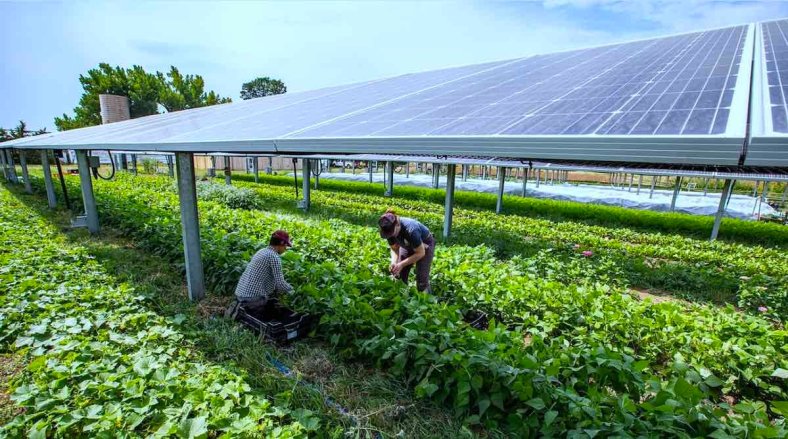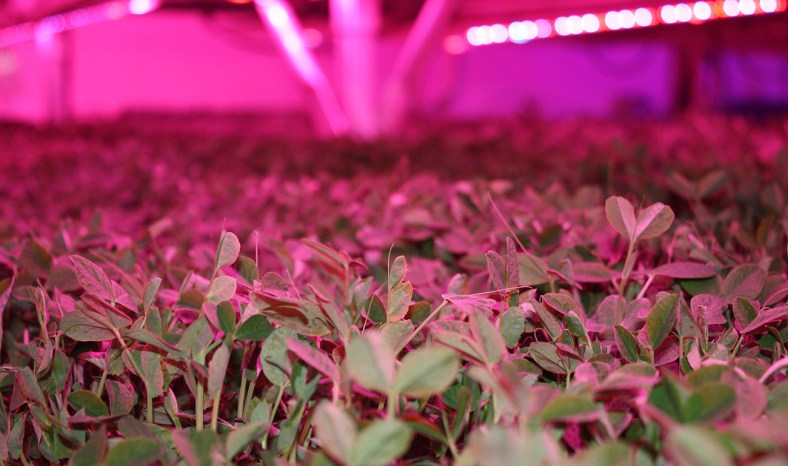Bruce Bugbee, professor of crop physiology at Utah State University, refers to the exclusive use of LEDs in closed indoor farms as electric light agriculture. He said no matter how efficient LEDs become, they are still competing with free photons from the sun. Photo by John Frey
While controlled environment agriculture continues to expand, there is still the question of whether it can simultaneously achieve both economic and environmental sustainability.
Even as controlled environment agriculture companies go out of business or file for bankruptcy, investors see economic opportunities. New indoor farms are coming online and others are expanding their operations. These investors, however, often overlook the economic and environmental sustainability issues of growing food without sunlight and focus on CEA’s yield advantages over traditional outdoor farming.
“Some people confuse profitability with environmental sustainability,” said Bruce Bugbee, professor of crop physiology at Utah State University and president of Apogee Instruments. “Not all things that are profitable are good for the environment. We often assume that indoor ag is good for everyone.
“If a grower can stay in business, it must be good for the environment. That’s not necessarily the case. A company that stays in business is economically sustainable, but this doesn’t always mean it’s environmentally sustainable.”
Bugbee presented the keynote address at the recent GLASE 2023 Summit, which focused on Greenhouse Energy Resilience.
“Indoor agriculture should include both greenhouses and indoor farms,” he said. “The difference is that greenhouses use natural sunlight and indoor farms use electricity to generate photons for photosynthesis. The exclusive use of LEDs in closed indoor farms should be called electric light agriculture. Plants can’t tell whether photons are coming from electric lights or the sun. Photons from the sun are free, while photons from lights are generated from electricity. No matter how efficient LEDs become, they are still competing with free natural photons from the sun.”

High input agriculture
Bugbee uses the term high input agriculture to include a wide variety of production systems.
“Horticultural food production is much higher input than agronomic food production,” he said. “More energy is used to grow tomatoes than soybeans or corn. It’s just the nature of the crops. Horticulture is high input and high value. Protected horticulture is higher input than field horticulture.
“Electric light agriculture is even higher input. Some people assume that high input agriculture will save the planet because it has the potential to use less water and fertilizer. But electric light agriculture currently uses fossil fuels.”
Bugbee said there is the potential to use renewable energy sources, including solar and wind.
“It takes a lot of photons to grow food crops,” he said. “But even the most efficient solar panels coupled with the most efficient LEDs, it takes 2 acres of solar panels to provide the equivalent of sunlight for 1 acre of greenhouses. Direct use of sunlight for photosynthesis is efficient, but it could be considered a lower-tech solution.”
One of the factors driving interest in electric light agriculture is climate change.

“Investors in indoor agriculture often refer to the risks of growing crops outdoors,” Bugbee said. “My experience is that growing crops without sunlight is economically risky. Growing indoors is dependent on a steady supply of energy. Many of the bankruptcies that have occurred with electric light agriculture operations in Europe were caused by political events like the Ukraine war, which impacted the cost of energy.
“Greenhouses are somewhere in the middle. They are protected and utilize free sunlight. The level of sunlight is much less in the winter than in the summer, but it is still a predictable resource. The supply of cheap energy is less predictable.”
Potential of agrivoltaics
Bugbee said one source of sustainable energy that has the potential to improve controlled environment agriculture energy efficiency is agrivoltaics. Agrivoltaics, which is also referred to as agrisolar, uses land for both agriculture and solar photovoltaic energy generation.
“Agrivoltaics offers the direct use of sunlight as much as possible,” Bugbee said. “Greenhouses could be outfitted with solar panels that can be rotated to shade in the summer and open in the winter depending on how much light is needed by the crops.”
When there is too much heat from the sun, the solar panels can be rotated to produce more electricity. During winter when there is less sunlight, the panels can be oriented vertically and allow the maximum amount of sunlight to be delivered directly to the crops.
“This helps to provide temperature control and combined production of electricity with food production,” he said. “This facilitates the direct use of sunlight.
“Field crops are being grown under appropriately-spaced solar panels and this provides partial shade in the summer. For some crops, the light could be reduced by half during the middle of the day without significantly reducing yield. There is so much sunlight available during the middle of the day that the plants can be light saturated. Agrivoltaics provides both electricity production and food production in these systems. This high-input agriculture approach has a promising future.”

Improving the efficiency of LEDs
Bugbee said the improvements in LEDs over the last 10 years has increased their energy efficiency to almost 90 percent.
“With further R&D the efficiency of LEDs might be increased to 95 percent,” he said. “But the rate of improvement in efficiency is going to be much less than what has occurred over the last 10 years. The perfect device would be all light and no heat. LEDs approach this, but there is still energy in the photons and there is no way to produce a photon without energy.”
Bugbee predicts two things will continue to occur with LED grow lights: a reduction in cost and an improvement in reliability.
“Reliability has largely happened,” he said. “Ten years ago, manufacturers claimed LED grow lights would last 50,000 hours, but they didn’t last as long as the high pressure sodium lamps we were using. It wasn’t the LEDs, it was some other light system component like the power supply that would fail. Those issues have been largely resolved.”
Bugbee said LED fixtures are now far more reliable and will continue to improve.
“Photons from LED grow lights are still more expensive than photons from double-ended high pressure sodium fixtures in terms of initial capital costs,” he said. “But I see the cost of LED fixtures continuing to decrease because of economies of scale.
“Optimizing the light spectrum for individual crops will also improve light efficiency, but most of the biggest advances have already occurred, at least in our laboratory research. I don’t see further spectral optimization doubling yield, but increases of 20-30 percent are still on the horizon, and every increase provides exciting new opportunities”
For more: Bruce Bugbee, Utah State University, Department of Plants, Soils, and Climate, bruce.bugbee@usu.edu; https://caas.usu.edu/labs/cpl/. Apogee Instruments Inc., https://www.apogeeinstruments.com/.
Editor’s note: Bruce Bugbee will be doing a presentation on “Principles of nutrient and water management for indoor agriculture” at VertiFarm2024, the 3rd International Workshop on Vertical Farming, in Bologna, Italy, Jan. 16-19, 2024.
This article is property of Urban Ag News and was written by David Kuack, a freelance technical writer in Fort Worth, Texas.



2 Comments
I enjoyed the article about CEA in 2024
LED technology has come a long way – but it’s tough to compare them to free light from the sun. Agrivoltaics seems like the best of both worlds.